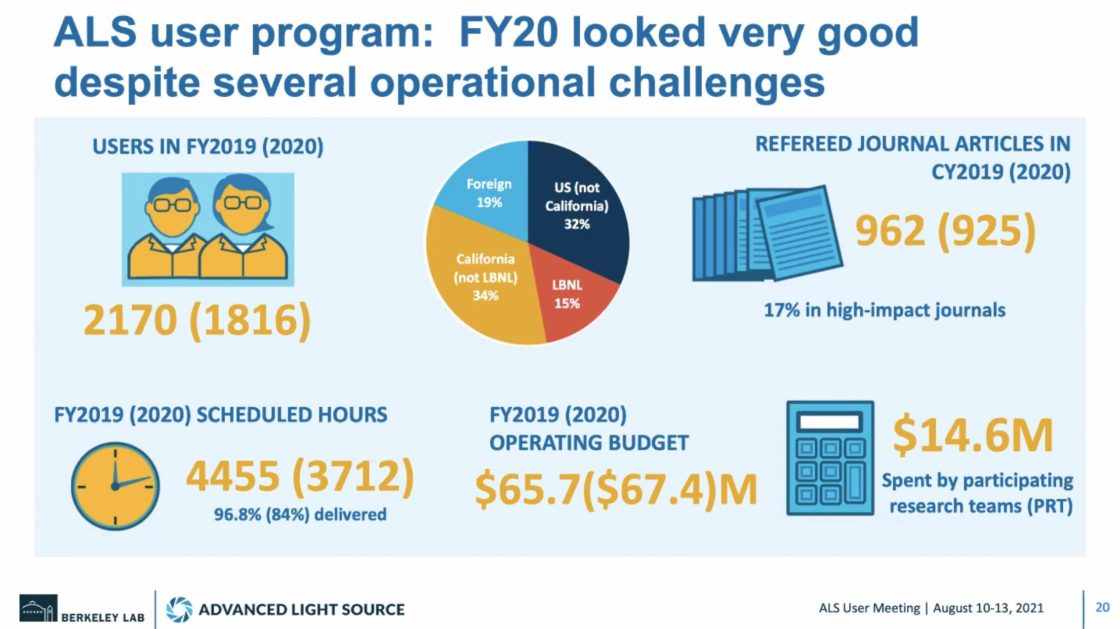by Cindy Lee
The Advanced Light Source (ALS) held its annual user meeting August 10–13, 2021, co-chaired by Users’ Executive Committee (UEC) members Alex Frano and Hope Michelsen. Like the 2020 virtual meeting, this year’s event was on the now-familiar Zoom platform with the elements of in-person user meetings. A benefit of the virtual platform was the increased number of people who could attend; almost 400 attendees on six different continents joined the plenary sessions.


ALS Director Steve Kevan gave an overview linking the ALS’s storied past to all the developments that are yet to come. His talk contextualized the work at the ALS in the constellation of light sources in the Department of Energy (DOE) complex and around the world. Kevan described the user experience at all stages of training, from Ryan Muzzio, a student who spoke to Congress about the impact of COVID-19 on his research, to Jennifer Doudna, a former UEC chair who performed her structural biology studies at the ALS and won the Nobel Prize in Chemistry in 2020 for her work on CRISPR.
Next was a DOE update from Associate Director of Science for Basic Energy Sciences Linda Horton. She detailed some recent DOE staffing changes, including the confirmation of Secretary of Energy Jennifer Granholm. In addition, Horton gave a preview of the Lessons from the COVID Era and Visions for the Future Report, with discussions about the challenges of remote work and the opportunities for collaboration in remote, hybrid, and on-site environments.
The presentation of the David Shirley Award for Outstanding Scientific Achievement at the ALS is always a highlight of the User Meeting. This year’s segment was particularly poignant after the recent passing of David Shirley. His son, Eric Shirley, and his former student, Steve Kevan, paid tribute to the former Berkeley Lab director who was instrumental in having the ALS built. Eric Shirley shared a lesson from his father: “Whatever you do, do your job well, because it’s what you’re going to be spending your time doing.” Shirley and Kevan agreed that this year’s award recipient, David Prendergast, indeed does his job well. His theory and modeling work at the Molecular Foundry complement and enhance x-ray spectroscopy experiments at the ALS. Prendergast elaborated on this intersection of theory and experiment in his talk, “Seeing Molecules and Materials in Action through Simulated X-Ray Spectroscopy.”
To kick off the Poster Slam, ALS Administrator Andrea Taylor performed “Ain’t No Science,” a parody of “Ain’t No Sunshine.” Contestants in the student poster competition then had one minute each to describe their research, enticing audience members to learn more in the poster session.
The 2021 User Meeting keynote speakers covered a diverse range of topics, from Claire Acevedo’s (University of Utah) insights into bone fragility to Jeff Terry’s (Illinois Institute of Technology) discussion of the need for closer attention to data analysis. In her talk, Ada Yonath (Weizmann Institute) described the curiosity that led her to uncover the secrets of the ribosome. Julia Mundy (Harvard University) explained how she turned the transition metal portion of the periodic table into a playground for novel applications. Finally, Stan Whittingham (Binghamton University) described how synchrotron research powered his work in lithium batteries. A full list of speaker and presentation information is available online.
A highlight of the meeting was a new feature—a panel discussion with Nobel Chemistry Laureates Stan Whittingham and Ada Yonath. UEC Chair Johanna Nelson Weker posed questions to the pair, who related many insights from their careers. Yonath reminisced about painstakingly growing crystals and the technological advances in structural biology that she’s seen. She even shared the enigma she’s approaching next—how a virus convinces a host to make proteins. Through it all, love has been central to her work. “Love. Love your work, love your family, love life,” she said. “Do what you love,” Whittingham agreed, and added, “The most interesting science is at the interface of disciplines.” He discussed the need for scientists and politicians to be involved in a more sustainable future. The two also had some time for more fun topics, like alternate careers. If they weren’t scientists, Yonath would be a writer, and Whittingham would grow cacti.
During the award ceremony, Andrea “Andi” Jones received the Tim Renner User Services Award “for her dedication and commitment in supporting the User Services Office that have allowed efficient proposal reviews and beamtime allocations during the pandemic.” Simon Leemann, Alex Hexemer, Shuai Liu, Yuping Lu, C. Nathan Melton, Hiroshi Nishimura, Changchun Sun, and Dani Ushizima received the Klaus Halbach Award for Innovative Instrumentation at the ALS “for the development of a machine-learning-based application to stabilize the transverse beam size and enhance the photon-beam performance of the ALS.” The Neville Smith Student Poster Award, First Prize, went to Abe Levitan (MIT) for “Spectroscopic Soft X-Ray Imaging with RPI.” For Second Prize, there was a three-way tie: Alauna Wheeler (UC Merced) for “Structural Study of Gel Inside Electro-Sensory Organs of Cartilaginous Fishes,” Ian Wang (Yale) for “Sub-Resolution Energy Gap Extraction,” and Megan Finnigan (University of Colorado Boulder) for “Zooming in on STXM Analysis.”

Over 400 attendees joined the eleven workshops and tutorials on days 3 and 4. Full descriptions and available recordings are posted online. In addition to the introductory material in Light Sources 101 and deep-dive sessions on specific techniques, attendees also joined the Envisioning Remote Access after the Pandemic Workshop. As participants looked to the future, they reflected on strategies that have already proven useful in remote and hybrid work.
Connecting the past with the future was an ongoing theme; the User Meeting was a chance to reflect on all that the ALS community has accomplished in the past year and prepare for what is to come. As Kevan remarked when he discussed the ALS Upgrade Project, “The future is bright.”